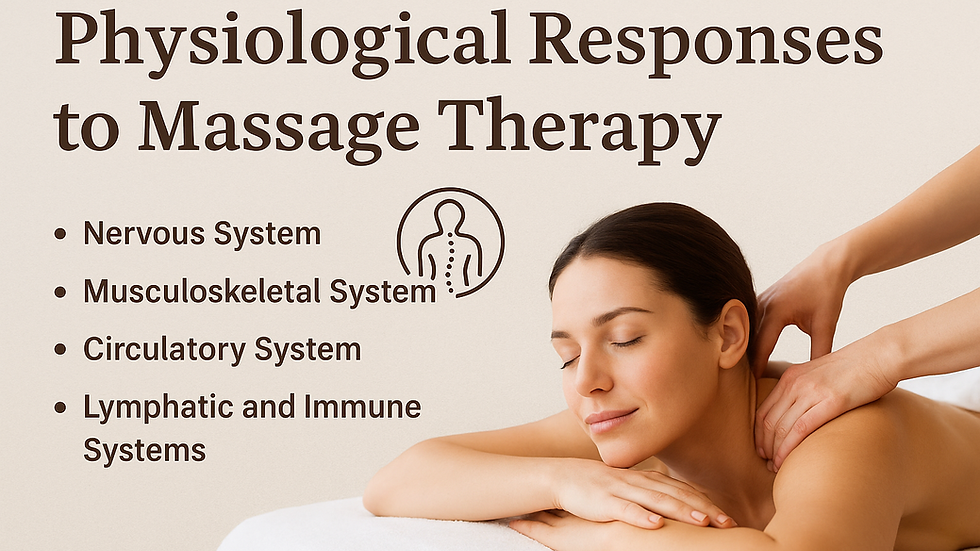The Science of Massage Therapy: Unlocking the Benefits of Healing Touch
- Brittiany

- Sep 21
- 4 min read
Updated: 6 hours ago

Understanding the Impact of Massage Therapy
Massage therapy isn’t just a luxury—Sacred Sanctuary's massage services provide therapeutic interventions with powerful physiological effects. From stress relief to pain management, the body responds to massage in ways that impact nearly every system.
In this blog, I’ll explore the physiological responses to massage therapy, backed by science and clinical research. Whether you’re an athlete, a healthcare provider, or simply someone seeking better wellness, understanding these effects will show you why massage is far more than relaxation.
Nervous System Responses to Massage
Massage influences the nervous system immediately. It alters how the body processes pain and stress.
Stimulation of Mechanoreceptors
Massage activates specialized nerve endings in the skin and muscles. This activation leads to several benefits:
Reduced pain signals: The body feels less pain.
Promoted relaxation: Tension melts away.
Improved proprioception: You become more aware of your body.
Pain Modulation
Through the Gate Control Theory, non-painful touch can block pain signals before they reach the brain. Additionally, massage increases natural painkillers like endorphins and enkephalins. This means that massage not only feels good but also helps manage pain effectively.
Parasympathetic Activation
Massage shifts the body from sympathetic (fight or flight) dominance to parasympathetic (rest and digest). This shift results in:
Slower heart rate: Your heart calms down.
Lower blood pressure: Your body relaxes.
Deeper breathing: You take in more oxygen.
A sense of calm: Stress fades away.
Musculoskeletal Responses to Massage
Massage directly affects muscles, tendons, and fascia. Here’s how:
Muscle Relaxation and Tension Reduction
Techniques like kneading and stretching lengthen muscle fibers. They decrease spasms and release trigger points, making you feel more comfortable.
Improved Circulation in Muscles
By boosting blood flow, massage delivers oxygen and nutrients to tissues. It also flushes out lactic acid and other waste products, which can help reduce soreness.
Fascial Release
Massage stretches fascia, the connective tissue around muscles. This restoration of mobility reduces stiffness and enhances flexibility.
Injury Recovery Support
Massage enhances tissue repair, reduces scar tissue buildup, and accelerates rehabilitation after injury. Athletes and active clients often choose deep tissue massage at Sacred Sanctuary to release muscle knots and improve recovery.
Circulatory System Responses
Massage acts like a mechanical pump for the cardiovascular system. Here are some key benefits:
Increased blood flow: Oxygen and nutrients are delivered efficiently.
Lower blood pressure and heart rate: This promotes cardiovascular health.
Enhanced venous return: It reduces swelling and improves circulation in the limbs.
Lymphatic and Immune System Responses
Massage doesn’t just help blood circulation—it also supports immune health.
Lymphatic Drainage
By stimulating the lymphatic system, massage clears toxins and reduces swelling. It helps manage conditions like lymphedema, which can be a significant relief for many.
Boosted Immunity
Research shows massage increases lymphocytes and natural killer cell activity, strengthening immune defenses. This means that regular massage can help keep you healthier.
Endocrine and Hormonal Responses
Massage therapy changes the body’s chemistry by influencing hormone levels. Here’s how:
Lower cortisol levels: This reduces stress and supports healing.
Increased serotonin and dopamine: These hormones improve mood and mental health.
Improved melatonin regulation: This supports healthy sleep cycles.
Respiratory System Responses
Massage promotes better breathing by:
Relaxing the diaphragm and intercostal muscles: This helps ease tension.
Encouraging deeper, slower breaths: You take in more oxygen.
Supporting conditions like asthma and anxiety-driven breath restriction: This can be particularly beneficial for those struggling with these issues.
Psychological Benefits of Physiological Changes
The mind and body are interconnected. The physiological effects of massage translate into psychological benefits:
Reduced anxiety and depression symptoms: You feel lighter and more at ease.
Enhanced mood and emotional well-being: Life feels more manageable.
A greater sense of safety and relaxation: You can truly unwind.
Clinical Applications of Massage Therapy
Massage is used across healthcare and wellness settings for its wide-ranging effects. Here are some common applications:
Pain Management
Massage is effective for conditions like arthritis, fibromyalgia, chronic back pain, and post-surgical recovery. It can be a vital part of a pain management plan.
Sports and Recovery
Athletes use massage for faster recovery, reduced muscle soreness, and injury prevention. It’s a key component in their training regimen.
Mental Health Support
Massage helps manage anxiety, depression, PTSD, and stress-related disorders. It can be a soothing addition to traditional therapies.
Palliative Care
Gentle massage improves comfort, relaxation, and quality of life for terminally ill patients. It offers a compassionate touch during difficult times.
Evidence-Based Research on Massage Therapy
Scientific studies confirm the physiological responses to massage:
Reduced cortisol and stress levels: This shows how effective massage can be.
Lowered blood pressure and heart rate: These are crucial for heart health.
Boosted immune activity: This helps keep you well.
Enhanced recovery in athletes: This proves its effectiveness in sports.
Massage therapy continues to be studied for conditions such as hypertension, cancer-related fatigue, and neurological disorders. The evidence keeps growing.
Limitations and Safety Considerations
While beneficial, massage therapy is not suitable for everyone. Here are some important considerations:
Avoid deep massage if you have blood clots, fractures, or infectious skin conditions. Your safety is paramount.
Outcomes depend on therapist training and techniques: Always seek a qualified professional.
Massage should complement—not replace—medical treatment: It’s part of a holistic approach to health.
Why Massage Works on Every Level
Massage therapy is far more than relaxation. It creates measurable physiological responses across the nervous, muscular, circulatory, lymphatic, and endocrine systems. These changes explain why massage supports:
Pain relief: You feel better physically.
Faster recovery: Your body heals more quickly.
Stress reduction: You can relax and recharge.
Improved immunity: You stay healthier.
Emotional well-being: You feel good inside and out.
As research grows, massage is increasingly recognized as a scientifically validated tool for holistic health.
Ready to experience these benefits yourself? Book your next massage therapy session at Sacred Sanctuary today!




Comments